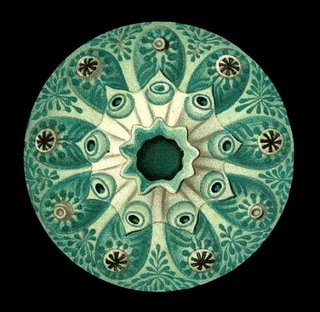Lotte Glob is a Danish ceramics artist living and working in Scotland. Her work is intimately inspired by forms she finds in nature, especially around the Ultimate Rock Garden, as she calls her Scotland studio and home. I'd love to live and work in a place like this someday: 
Glob has a beautiful online portfolio exhibiting her ceramic sculptures, books, fountains, tiles and bowls. These are incredibly beautiful pieces -- if you are at all attracted to artwork based on natural colors, shapes and textures, check out her portfolio. This is one of her pieces, ceramic floating stones, photographed in place on the shore. She often places her sculptures in nature to take photos of them before delivering them to the buyers.
Here's another, a comissioned fountain. Shown are some of the glaze shapes up close.
I like Glob's ceramic "books" -- Books of the Land, Earth Air, Fire and Water elements shaped into the pages and covers of book forms. Here is a detail of one of Glob's books.
Nature is the source of most of my own artistic and creative inspiration and it's right outside our house. In Helena, it literally takes just a couple of minutes to get from "town" out into a more natural environment. But even right in town, all I have to do is get down on my hands and knees with my eyes, my camera, my sketchbook, my sense of wonder... to find something inspiring and worth using in my artwork.
Speaking of finding inspiration in nature, last weeks Painter's Keys Letter from artist Robert Genn, was all about being inspired, influenced, shaped as artists by ... Nature and natural forms. Here is what he writes in his weekly letter:
"Here are a few non-rigid thoughts for those who might be thinking about nature in their art:
Gradations attract, enfold and please.
Curves are more sensual than straights.
The obvious is enchanted by the hidden.
Protrusions are contrasted with indentions.
Patterns fascinate, involve and deceive.
Repetitions are to forms what beats are to music.
Symmetry mirrors and honours the human body.
Whorls and vortexes tempt and seduce.
Colour, pure or muted, is its own magic.
Strong contrasts provide drama and excitement.
Soft edges invite touch and caress.
Disappearing acts create mystery and intrigue.
Camouflage has both honour and mirth.
Bracts and branches are a principle of life.
Articulation rattles the bones.
Spikes and spines provide discomfort and unease.
Radiation echoes a sun god and the hand of man.
Water brings both tranquility and turbulence.
Squares and triangles give strength and stability.
The list goes on. Nature's designs range from high schlock to understated good taste. They present us with an ever-changing march of variety and magnificence. "Nature," says biologist Hans Meinhardt, "has been allowed to play." Artists may take courage from this cue." ---- Robert Genn, from the Painter's Keys.
Another artist -- a photographer,
Karl Blossfeldt made a large body of work in the 1920s and 30s, photographing natural plant forms. A recent project over at the Utata artists' group was the
"Utata Pays Homage to the Masters" exhibit. Some Utata photographers chose to honor Blossfeldt with their own beautiful plant-forms photos. Here's one by a Utatan and Flickr photog,
Brenda Anderson, titled
Koru:
Here's a link to one of Blossfeldt's black and white photos ... of a
fern fiddlehead similar to Brenda's above.
Karl Blossfeldt has several books out, some published by Dover, all are wonderful collections of botanical diversity and most can be found online as used books.
 Aqua-Nine Flower
Aqua-Nine Flowerby Ernst Haeckel
Ernst Haeckel was a 19th century zoologist who supported Darwin's theory of evolution. He was also an
amazing artist. I've used his book, originally published in 1899, as inspiration for years and years:
Art Forms in Nature, or
"Kunst Formen der Natur" (the original title)
. His illustrations are stunning -- they were drawn and painted by Haeckel from life yet many of the creatures look as if they were from another planet! It's weird that both Haeckel and Blossfeldt have books with the same titles, though Haeckel concentrates on animal forms and Blossfeldt focues on plant forms ... both books are excellent source of the many beautiful patterns, textures and forms found in nature. Both books can usually be found used online. Definitely worth checking out.








